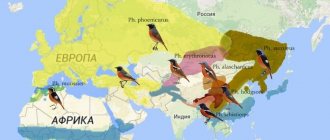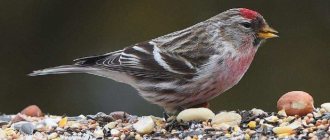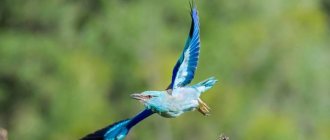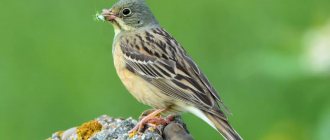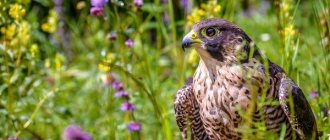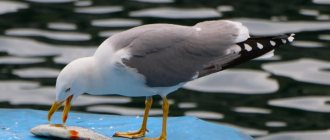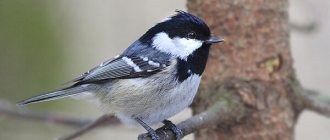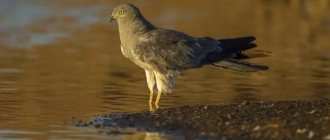- Wild animals
- >>
- Birds
The common kestrel looks very noble and beautiful, this is not surprising, because the bird is a representative of the falcon family. Many people are completely unfamiliar with this feathered creature, so it will be interesting to understand the origin of such an unusual bird name, give a description of the bird’s appearance, and characterize its habits, disposition and life activity in general.
Origin of the species and description
Photo: Common kestrel
The common kestrel is a bird of prey that belongs to the falcon family and belongs to the order Falconiformes. Kestrel is the name of several species of birds from the falcon family. In total, there are more than a dozen species of this bird. Only a couple of them live on the territory of our country: the steppe kestrel and the common kestrel, which will be discussed.
Video: Common kestrel
The origin of the name of this bird is interesting, about which there is more than one version. In Russian, the name of the bird sounds like “kestrel”, in Belarusian – “pustalga”, in Ukrainian – “boriviter”. The word "kestrel" means "empty". The dictionary of Russian synonyms offers such a synonym for this word as “dummy”. In connection with this meaning, there is an erroneous assumption that the bird was so nicknamed due to the fact that it is not adapted to falconry, although this is not the case, it is considered a hunter.
Another version is more plausible; according to it, the name “kestrel” comes from the method of hunting in open areas (pastures), where the root “pass” is taken as a basis, so the name used to sound like “pastel” and meant “looking out.” The Ukrainian name for the bird indicates that while soaring in the air, the bird moves towards the wind, overcoming its gusts. Scientists divide all kestrels into four large groups, without uniting them into one family clan, because believe that they do not have one common ancestor.
The following groups are distinguished:
- common kestrel;
- real kestrel;
- African gray kestrel;
- American (passerine) kestrel (the group consists of one species).
The first group includes such varieties of kestrels as: Madagascar, Seychelles, Mauritian, common, Australian (gray-bearded), Moluccan. If we give a brief description of the appearance of the common kestrel, we can say that it is very similar to a falcon, only very miniature. The length of the bird's body varies from 30 to 39 cm, and its weight ranges from 160 to 300 grams.
Interesting fact: The common kestrel was the bird of 2006 in Switzerland, 2007 in Germany and the symbol of the Russian Bird Conservation Union in 2002.
Footnotes [edit]
- ^ a b BirdLife International (2013). » Falco tinnunculus » . IUCN Red List of Threatened Species
.
2013
. Retrieved November 26, 2013. Old form URL - Mangoverde World Guide Bird 2009
- “Common Kestrels | Beauty of the Birds". www.beautyofbirds.com
. Retrieved January 5, 2022. - ^ B s d e g h i JK Orta 1994
- Wiles et al. 2000
- ^ ab Wiles et al. 2004
- Inskipp, Inskipp and Sherub 2000
- Viitala et al. 1995
- Mikula, Hromada and Tryjanowski 2013
- Steen, Löw and Sonerud 2011a
- Steen et al. 2011b
- Alamo Tavio 1975
- López - Idiáquez, D.; Fargallo, J. A.; López - Rull, I.; Martinez-Padilla, J. (2019). "Plumage color and personality in early life: sex differences in signaling." Ibis
.
161
(1):216–221. DOI: 10.1111/ibi.12665. - Martinez-Padilla, J.; Vergara, P.; Fargallo, J. A. (2017).
lifetime
reproductive success of first-time siblings of the common kestrel Falco tinnunculus Ibis
.
159
(4):803–811. DOI: 10.1111/ibi.12494. - ^ a b, age 2010
- ↑
Possibly dated to the Early Pleistocene. - ^ ab See Groombridge et al. 2002 for a detailed discussion of the divergence times of the common kestrel and its relatives.
- Peterson et al. 2008
- ^ ab Rasmussen and Anderton 2005
- Whistler 1949, pp. 385-387
- Mlikovský 2002, pp. 222-223
- Mourer-Chauviré et al. 2003
- Phillott, D.C. (1832). "A Note on the Common Kestril (Tinnunculus alaudarius)". Journal of the Asiatic Society of Bengal
.
2
(10): 527–528. - ^ a b "kestrel". Oxford English Dictionary
(Online ed.). Oxford University Press. (Subscription or membership at a participating institution is required.) - Weekly 1921
- In short, the Oxford English Dictionary
. United Kingdom: Oxford University Press. 2007. p. 3804. ISBN 978-0199206872. - Jobling, James A (2010). Helm's Dictionary of Scientific Names for Birds. London: Christopher Helm. pp. 266, 386. ISBN 978-1-4081-2501-4.
Appearance and features
Photo: Common kestrel in flight
The common kestrel is a small-sized feathered predator. It should be noted that females are larger than males. Their average weight is 250 grams, and males have much less weight - about 165 - 200 grams. The wingspan of these birds reaches 76 cm. The colors of the plumage of the male and female also differ. The color of the female individual is uniform, but the color of the male’s head differs from the tone of the entire body; it has a light gray, slightly bluish tint. The female has a brownish head, matching the whole body.
The male's dorsal area, which has a brownish tint, has small black specks resembling the shape of diamonds. The lumbar region of the male and his tail tail feathers are also light gray. The very end of the tail is decorated with contrasting black stripes edged with white. The undertail is colored beige or cream and has a pattern of dashes or spots of a brownish tone. The inner side of the wings of the male kestrel is almost white.
Mature females have dark stripes on the back, which are located across the body. The brown tail is also lined with transverse stripes and has a contrasting border. The abdominal part has a darker tone compared to males; there are many more spots on it. The young are similar in appearance to the females, only they have shorter and rounded wings. The color of the wax and the area around the eyes also varies: in mature birds it is yellow, and in young birds it is greenish-blue.
The tail, both in males and females, has a rounded shape, because the middle feathers are longer than the outer tail feathers. The tips of the wings in mature individuals extend to the very tip of the tail. The limbs are dark yellow, and the claws on them are black. In general, the kestrel’s physique is quite harmonious and fine. Large round eyes and a hooked, but neat beak stand out clearly on the head. From its entire appearance and appearance, it becomes clear that this is a bird of prey of noble falcon blood.
Where does the common kestrel live?
Photo: Common kestrel in nature
The habitat of the common kestrel is very extensive; it has chosen not only different countries, but also different continents. The bird lives in the spaces of Europe, Africa, Asia. This species of kestrel has inhabited almost the entire Palearctic region (the territories of Europe, Asia just north of the Himalayas, northern Africa, extending to the southern borders of the Sahara).
The kestrel adapts well to a variety of climatic conditions and landscapes, preferring flat terrain. Birds avoid both very dense forest thickets and completely treeless steppe areas. In Central Europe, birds can often be found on forest edges, in copses and even in cultivated landscapes. The kestrel is most often stationed in open spaces with low bushy vegetation, where the food supply is abundant.
The bird can perfectly adapt to different altitudes, the main thing is that there is enough food there, so mountain ranges are not at all alien to it. For example, in the Alps, birds live at an altitude of up to three and a half kilometers, and in Tibet they can be found at the five-kilometer mark. Birds prefer to nest in trees, but in their absence, they build nests on high-voltage power poles and simply on the surface of the ground.
Interesting fact: The kestrel does not shy away from humans at all, and more and more often it can be seen within the boundaries of cities (especially European ones), the bird is registered in human settlements or occupies the ruins of old houses.
The most striking example of the settlement of kestrels in an urban environment is Berlin; these birds are already considered typical residents there. Since the late eighties of the last century, ornithologists began to study the life activity of these birds in urban habitats.
Now you know where the common kestrel bird lives. Let's see who she hunts and what she eats.
Links[edit]
- Alamo Tavio, Manuel (1975). Asociación Canaria para Defensa de la Naturaleza (ed.). "Aves de Fuerteventura en peligro de extinción" [Endangered Birds of Fuerteventura]. Aves y Plantas de Fuerteventura en Peligro de Extinción
(in Spanish): 10–32. - "Life history data for Falco tinnunculus". AnAge
. 2010. Archived from the original on March 2, 2012. Retrieved August 1, 2010. - Groombridge, Jim J.; Jones, Carl G.; Bayes, Michelle K.; van Zyl, Anthony J.; Carrillo, Jose; Nichols, Richard A.; Bruford, Michael W. (2002). "Molecular phylogeny of African kestrels with reference to divergence across the Indian Ocean" (PDF). Molecular phylogenetics and evolution
.
25
(2): 267–277. DOI: 10.1016/S1055-7903(02)00254-3. PMID 12414309. Archived from the original (PDF) on September 14, 2007. - Inskipp, Carol; Inskipp, Tim; Sherub (2000). "Ornithological significance of Thrumshingla National Park, Bhutan" (PDF). Forktail
.
14
: 147–162. Archived from the original (PDF) on August 10, 2014. Retrieved April 17, 2015. - "Eurasian kestrel Falco tinnunculus". mangoverde.com
. Mangoverde World Bird Guide (MWBG). 2009. Archived from the original on December 7, 2008. Retrieved January 2, 2009. - Mikula, P.; Hromada, M.; Tryanovsky, P. (2013). "Bats and swifts as food for the European kestrel (Falco tinnunculus) in a small town in Slovakia" (PDF). Ornis Fennica
.
3
: 178–185. Archived from the original (PDF) on December 03, 2016. Retrieved April 17, 2015. - Mlikovsky, Jiri (2002). Cenozoic Birds of the World (Part 1: Europe) (PDF). Prague: Ninox Press. Archived from the original (PDF) on May 20, 2011. Retrieved December 12, 2022. ISBN 80-901105-3-8
- Mourer-Chauviré, C.; Philippe, M.; Quinif, Y.; Chaline, J.; Debard, E.; Guérin, C.; Hugueny, M. (2003). "The position of the paleontological site of Aven I de Abim de la Fage at Noailles (Corrèze, France) in European Pleistocene chronology." Borey
.
32
(3):521–531. DOI: 10.1111/j.1502-3885.2003.tb01232.x. - Horta, Jaume (1994). del Hoyo, Josep; Elliott, Andrew; Sargatal, Jordi (ed.). Common kestrel. Handbook of Birds of the World
. Volume 2 (New World Vultures to Guinea Fowl). Barcelona: Lynx Editions. pp. 259–260, table. 26. ISBN 978-84-87334-15-3. |volume=there is additional text (help) - Peterson, A. Townsend; Brooks, Thomas; Gamauf, Anita; Gonzalez, Juan Carlos T.; Mallari, Neil Aldrin D.; Dutson, Guy; Bush, Sarah E.; Fernandez, Renato (2008). "Avifauna of Mount Kitanglad, Bukidnon Province, Mindanao, Philippines" (PDF). Fieldiana Zoology
.
New episode. 114
: 1–43. DOI: 10.3158/0015-0754 (2008) 114 [1:TAOMKB]2.0.CO; 2. Archived from the original (PDF) on 09/02/2009. Retrieved May 11, 2009. - Rasmussen, Pamela K.; Anderton, John S. (2005). Birds of South Asia.
Ripley's Guide . Volume 2. Washington, DC and Barcelona: Smithsonian Institution and Lynx Edicions. pp. 112–113. |volume=there is additional text (help) - Steen, R.; Løw, L.M.; Sonerud, T. (2011a). "The delivery of common lizards (Zootoca Lacerta vivipara
) to Eurasian kestrel (Falco tinnunculus) nests is determined by solar altitude and ambient temperature."
Canadian Journal of Zoology
.
89
(3):199–205. DOI: 10.1139/z10-109. S2CID 67822269. - Steen, R.; Løw, L.M.; Sonerud, G. A.; Selås, V.; Slagsvold, T. (2011b). "Rate of prey delivery as an estimate of prey consumption by the Eurasian kestrel ( Falco tinnunculus
)".
Ardea
.
99
: 1–8. DOI: 10.5253/078.099.0101. S2CID 84472078. - Swann, H. Kirk (1913). A Dictionary of English and Vernacular Names of British Birds. London: Witherby and Co., p. 134.
- Viitala, Jussi; Korpimäki, Erkki; Palokangas, Paivi; Koivula, Minna (1995). "Kestrel attraction to vole scent trails visible under ultraviolet light." Nature
.
373
(6513):425–427. Bibcode: 1995Natur.373..425V. DOI: 10.1038/373425a0. S2CID 4356193. - Weekley, Ernest (1921). An Etymological Dictionary of Modern English. London: John Murray. item 801.
- Whistler, Hugh (1949). A Popular Guide to Indian Birds (4th ed.). London: Gurney and Jackson.
- Wiles, Gary J.; Worthington, David J.; Beck, Robert E. Jr.; Pratt, H. Douglas; Aguon, Celestino F.; Pyle, Robert L. (2000). "Notable records of the birds of Micronesia with a summary of raptor sightings in the Mariana Islands, 1988–1999." Micronesica
.
32
(2):257–284. CiteSeerX 10.1.1.393.1140. - Wiles, Gary J.; Johnson, Nathan S.; de Cruz, Justine B.; Dutson, Guy; Camacho, Vicente A.; Kepler, Angela Kay; Vice, Daniel S.; Garrett, Kimball L.; Kessler, Kurt S.; Pratt, H. Douglas (2004). "New and noteworthy bird records for Micronesia, 1986–2003". Micronesica
.
37
(1): 69–96.
What does the common kestrel eat?
Photo: Common kestrel in Russia
The kestrel’s menu depends on the place of its permanent residence, so it is very diverse and consists of:
- small singing birds (for example, sparrows);
- wild rock pigeon chicks;
- small rodents (mainly voles);
- lizard;
- earthworms;
- water rats;
- all kinds of insects (grasshoppers, locusts, beetles).
It should be noted that, most often, young birds feed on invertebrates and insects, and mature birds eat them when they cannot find other food.
Interesting fact: To replenish its energy costs, a kestrel must consume an amount of food per day that is equal to one-fourth of its body weight. Two half-digested mice were often found in the stomachs of dead birds.
The kestrel has two main hunting tactics: it attacks either from a perch (poles, fences, branches) or directly in the air. The first hunting option is most effective in the cold season, and the second - in the warm season. The tactics of fluttering flight are very characteristic of this bird; the falcon freezes in one place in the heights, vigorously flapping its wings. The bird most often makes such an energy-consuming flight over those areas where it has spotted a lot of prey. When the prey is overtaken, it is held by sharp bird claws digging into the body, then the kestrel uses the technique of finishing off the caught prey with its beak in its occipital region. Such hunting maneuvers are familiar to many feathered predators.
Bird distribution
The kestrel's habitat covers Europe, western Asia and northern Africa. Some populations lead a sedentary lifestyle, others are migratory. Migrations mainly depend on the amount of food in the nesting areas. But usually from the northern regions of Europe and Asia there is a complete migration to the south of the European or African continent. Young animals make longer flights, and mature individuals remain close to their native places. From Russia for the winter, kestrels migrate to the east of the Mediterranean.
Features of character and lifestyle
Photo: Common kestrel bird
Every day the common kestrel flies around its hunting grounds. When the air flow is favorable, she glides beautifully in the air. These falcons are able to fly even in a closed space where there is no movement of air masses, and when they soar, the birds turn towards the wind. Bird eyes notice ultraviolet rays and urine marks left by rodents that stand out in this light. The brighter the glow, the shorter the distance to the potential victim; upon seeing it, the bird begins to rapidly dive down, grabbing it with its claws.
The ability to remain in quivering flight is a distinctive feature of the kestrel from other small falcons. During this flight, the kestrel opens its tail like a fan and makes frequent, intense flapping of its wings. Thus, the bird hovers at a height of 10 to 20 m and looks out for its snack. From the outside it looks quite beautiful and fascinating.
Interesting fact: The visual acuity of the kestrel is more than two and a half times higher than that of humans. If people had such vigilance, they could easily read the entire table in an ophthalmologist's office from a distance of ninety meters.
The sound range of kestrels is very diverse. Males can produce about nine different vocalizations, while females can produce about eleven. Frequency, vibration, volume and pitch depend on the particular situation for which the signal is issued.
Using ringing, scientists found that, depending on its place of permanent residence, the kestrel can be:
- nomadic;
- sedentary;
- migratory.
The processes of bird migration are influenced by the availability of food in the areas of bird settlement. Migratory birds fly low, they do not rise above one hundred meters, but more often they fly much lower than this mark (within 40 - 50 m). Even inclement weather is not able to stop the movement of a purposeful kestrel. Brave birds can overcome alpine ridges, because they do not experience much dependence on the direction of air flows. If the situation requires it, then bold feathered predators fly even over the tops of snow-capped icy mountains. This testifies to their hardy and persistent character.
Social structure and reproduction
Photo: Common kestrel from the Red Book
In Central Europe, the wedding bird season is observed from March to April. At this time, males make display flights to attract the attention of their partner. These aerial dances are characterized by steep turns, rotations around its axis, rapid glides, interrupted by the flapping of proudly spread wings. All these somersaults are accompanied by inviting exclamations, which should lure the young lady and mark the boundaries of the bird's domain.
The female herself calls her partner for intercourse, she flies closer to him and screams like a hungry chick, showing her readiness to mate. After this process is completed, the feathered cavalier rushes to the nesting site and calls the lady of his heart with the help of a ringing chant. Sitting on the nest, he continues to click and begins to scratch the nest, making an even deeper depression in it with his claws. When the female flies up, the gentleman jumps excitedly, jumping up. He does this so that his partner chooses his nest; the obviousness of the choice is influenced by the treat prepared in advance by the gentleman.
Interesting fact: If the kestrel's nest is not located on a tree, then it looks like a cleared platform or a small depression. Often the kestrel uses abandoned nests of others for its laying.
During the nesting period, birds can unite in groups of up to several dozen pairs. A kestrel's clutch can contain from 3 to 7 eggs, but more often there are 4 to 6. The incubation period lasts about a month. Both the male and the female incubate the eggs alternately. Newborn chicks are covered with white fluff, which quickly turns gray. The claws and beak of babies are painted white. At the age of one month, the chicks try to make their first flights, and when they are two months old, they begin to hunt independently. Birds become sexually mature when they are one year old. The avian life expectancy of the kestrel is about 16 years, but the mortality rate among chicks is very high, so that only half of the young survive to one year.
Offspring
The chicks appear within a month. They hear and see well right away. When born, the small falcon chicks are covered with the most delicate white down and have the same white beak and claws. In case of possible danger, they lie on their backs, sticking their sharp claws up, or simply lie at the bottom of the nest. Both parents are actively involved in their offspring. Children's appetite is "serious." They require a lot of food and often. In one day, while feeding their offspring, two parents destroy more than twenty small rodents! At this fertile time, they bring invaluable benefits to farmers and gardeners. And they say that it is an “empty” bird. They are mistaken, because its contribution to preserving the harvest is great! A young common kestrel slowly changes color to its adult plumage. At this time, the chicks are already interested in the life around them and demand even more food.
After 45-50 days, the small falcon cubs are ready for their first flight. At this time, you can see “gymnastic exercises” on the edge of the nest. Soon the common kestrel chicks will begin to fly and at the end of September - beginning of October will go with their parents to their wintering grounds.
Natural enemies of the common kestrel
Photo: Common kestrel
Although the kestrel is a predator, it has enemies in natural conditions, defenseless and inexperienced chicks are especially vulnerable, and clutches are also often subject to destruction. As already mentioned, birds living on forest edges often borrow other people's nests, namely magpies, rooks and crows. It is precisely these birds that are considered to be the natural enemies of kestrels. They commit predatory attacks not on mature birds, but on chicks and egg clutches. Kestrel nests can be destroyed by weasels and martens, which are not averse to snacking on both chicks and eggs.
The enemy of the kestrel is also a person who can destroy a nest only out of curiosity. People, conducting their vigorous activity, often displace birds from their usual inhabited habitats, although these birds have managed to adapt to life next to humans, settling in cities and towns. About thirty years ago, the kestrel suffered from hunters; now hunting it is very rare.
The enemies of the kestrel are often harsh natural conditions, which lead to the death of many birds. The mortality rate of birds is very high; those that remain to spend the winter in areas with a cold climate suffer the most. For the most part, falcons die not from frost, but from hunger, because in winter it is not easy to find food. Only 50 percent of chicks exceed the one-year age mark, which cannot but be alarming.
Vision
Strong claws on the paws and sharp vision come to the aid of the bird in obtaining food. The kestrel's vision is more than 2.6 times sharper than that of humans. If people had the same, then the ophthalmologist’s check table would be easily read from 90 meters! Experts say that the small falcon perfectly sees ultraviolet radiation. This gives him the opportunity to recognize the remains of rodent urine on the ground or grass. Thanks to this, the common kestrel can accurately track and kill these animals without much effort. The Falcon family is the family to which the kestrel belongs. Her squad, as you understand, is Sokoliny, and her clan is Falcons.
Population and species status
Photo: Common kestrel in nature
The populations of some species of kestrel are extremely small, so they are protected. As for the common kestrel, its population is considered the most numerous compared to other species of kestrels. According to IUCN estimates, the number of this bird in Europe varies from 819 thousand to 1.21 million individuals, which is from 409 to 603 thousand bird pairs. There is evidence that the number of birds that have chosen Europe is about 19 percent of the total number of these birds, which, according to various sources, ranges from 4.31 to 6.37 million mature individuals.
In the second half of the last century, there was a steady decline in bird numbers, but now, according to scientists, there is stability in the population size, which is good news. Still, there are a number of negative anthropogenic factors that adversely affect the life of the kestrel, because of which it is under protection in certain regions of our country. Such factors include the occupation of land for pastures, deforestation and timber harvesting, the occurrence of large fires, the use of pesticides in cultivated fields, where birds often hunt for all kinds of rodents.
